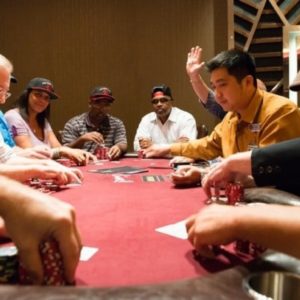Tips for Exploiting Table Image

One of the most important tools that a winning poker player possesses is an awareness of table image. They need to be aware of how other players perceive them. This can make or break a session. There are a few different methods to use table image to your benefit. You can exploit other players by tricking them using deceptive plays, or else you can create a false table image.
There are two basic types of good poker players. TAG and LAG are the acronyms tossed around when describing good, winning players. TAG is a player who is tight and aggressive. A LAG is a loose aggressive. Most famous poker personalities are LAG’s. Doyle Brunson, Tom “Durrrr” Dwan, Phil Ivey, and Gus Hansen are all LAG’s. Players who are at a table with a LAG expect them to play a wide variety of cards.
Taking Advantage of Big Hands as a LAG
A LAG might be able to play a big hand in a tricky way due to their image. Suppose you are at a table and have been raising almost any pot you are entering. When you pick up pocket Aces or Kings and you have been 3-betting a ton, then by all means continue. They are very likely to think you are continuing to pick on the table. They may play back at you or even shove.
Another move with a big hand pre-flop is to smooth call. Because your image is loose and aggressive they are going to be hard pressed to put you on a hand. They will certainly not put you on Aces or Kings. The rationale being that an aggressive player would play those hands aggressively.
Tight Players and Bluffing
If you have a tight image then you can take advantage of it by making well-timed bluffs or else slow playing big hands. Suppose you have AsKc and are on the button. The cutoff makes a standard raise. You might re-raise but if he knows you are tight he will fold. If the player is bad post-flop you might want to play a hand against them.
The flop comes 2s8sJc. The cutoff donk bets. You can float here because you still have equity against his range of hands, plus because of your tight image you can take the pot away if the right cards comes. The turn brings a 5c. The cutoff now checks. If you bet, you will have to fold to a raise. So you decide to check back. The river comes a 9s. This is a great card. Two different draws came in. Because you are in position and have a tight image this is a good card to bet.
You have the As which eliminates all AsXs combos from the player’s range. Because you flat called preflop your range is going to look like suited cards or pocket pairs. That means that you have sets, flushes, and straights in your range. The player, if they are aware of table image and are not a calling station, is going to fold a decent amount of the time in this spot.
If you have created a tight image you will be able to get away with well-timed bluffs. A player with a tight image is going to have a hard time getting max value from their hands unless there are calling stations at the table. Of course, if you overdo it, and get caught at showdown with complete air, then the image will change. Be aware of how other players play back at you, and watch what cards they do it with.
Pay Close Attention to the Image of Other Players
It is also important to be aware of other player’s table image. Some might behave like they are loose and crazy, but are really just limping and check folding. These are the players you should be wary of. If they every play back they have a hand.
If you in a pot with a bet or fold player and flop a monster, then check it back. Suppose you have pocket 9’s and flop top set on 2c6d9h then you would want to check it back. You want them to have a chance to hit something, even if it is only a draw. If the person is a calling station then by all means value bet them for three streets.
Understanding table image is one of the most important skills a poker player can learn. It is something that can turn you from a small winner into a big winner. Learn to watch how other player’s act and how they react to you, this will give you plenty of information about how to act.
